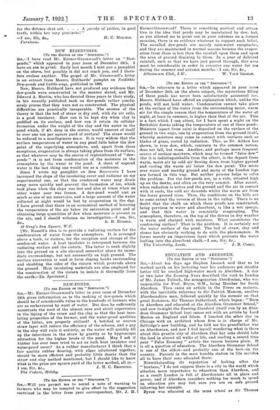DEW RESERVOIRS.
[To THE EDITOR Or THE " SPECTATOR."' RIX,—I have read Mr. Kerner-Greenwood's letter on " Dow- ponds," which appeared in your issue of December 24th. I have an axe to grind. Early last month I sent you a pamphlet on the above, but possibly it did not reach you, and I there- fore enclose another. The gospel of Mr. Greenwood's letter is an extract from Messrs. Hubbards' pamplet on Neolithic Dew-ponds and Cattle-ways, published in 1905.
Now, Messrs. Hubbard have not produced any evidence that
dew-ponds were constructed in the manner stated, and Mr. Edward A. Martin, who has devoted three years to their study, in his recently published book on dew-ponds rather conclu- sively proves that they were not so constructed. The physical difficulties are practically insuperable. The essence of the theory is that the bed of straw is dry and, with its air cells, is a good insulator. How can it be kept dry when clay is paddled on its surface, and how can it retain its cellular formation under the weight of the clay and the water in the pond which, if 4ft. deep in the centre, would amount of itself to over one ton per square yard of surface? The straw would be reduced to a mucilaginous mass. It is very seldom that the surface temperature of water in any pond falls below the dew point of the superlying atmosphere, and, apart from these exceptions, evaporation is always taking place from its surface, SO that whatever may be the source of replenishment of "dew- ponds " it is not from condensation of the moisture in the atmosphere by the water in the pond. A sheet of exposed water is the last thing one would use as a condenser.
Since I wrote my pamphlet on Dew Reservoirs I have
increased the slope of the insulating cover and radiator on my experimental one, so that the condensed water may drain away more quickly and prevent the formation of ice, which took place when the slope was less and also at times when no other water near was frozen. A dew-pond would cast as Much as one of my reservoirs, and a large amount of the water collected at night would be lost by evaporation in the day. I have proved that there is an economical method of lowering the temperature of the air below its saturation point and of obtaining large quantities of dew when moisture is present in the air, and I should welcome an investigation.—I am, Sir.
10 Gray's Inn Square, W.C.
[Mr. Russell's idea is to provide a radiating surface for the
condensation of water from the atmosphere. It is arranged above a tank, or cistern, for the reception and storage of the condensed water. A heat insulator is interposed between the radiating surface and the cistern. The latter is sunk slightly into the ground on a site elevated somewhat above its imme- diate surroundings, but not necessarily on high ground. The surface excavation is used to form sloping banks surrounding and shielding the sides of the cistern which protrude above the ground. Heat insulating materials are also employed for the construction of the cistern to isolate it thermally from the earth.—ED. Spectator.]










































 Previous page
Previous page